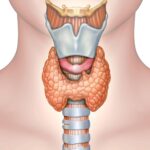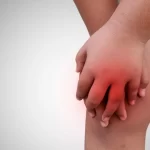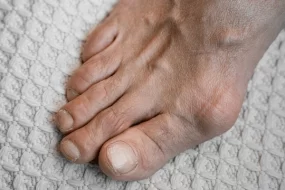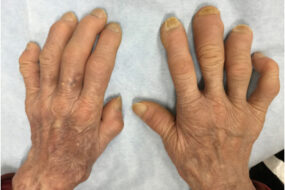- Home
- INTERNAL MEDICINE
- Rheumatology
- Rheumatoid arthritis

Rheumatoid arthritis (RA) is a chronic autoimmune inflammatory disorder characterized by symmetrical polyarthritis and may involve extra-articular systems. It leads to joint destruction and functional disability if untreated.
Epidemiology
- Incidence: Approximately 1-3 per 1,000 people annually.
- Prevalence: Affects about 0.5% to 1% of the adult population, more common in women (3:1 ratio).
- Age of Onset: Typically develops between ages 30 and 60.
Etiology
- Genetic Factors:
- HLA-DRB1: Specific alleles increase susceptibility.
- Family history of RA or autoimmune disorders.
- Environmental Triggers:
- Smoking: Increases risk, particularly in genetically predisposed individuals.
- Infections: Viral infections (e.g., Epstein-Barr virus) may act as triggers.
- Hormonal Influences: Increased prevalence in women suggests hormonal roles.
Pathophysiology
- Autoimmune Mechanism: The immune system targets the synovium, leading to chronic inflammation.
- Cytokine Release: Pro-inflammatory cytokines (TNF-α, IL-1, IL-6) drive inflammation and joint damage.
- Pannus Formation: Hyperplastic synovial tissue invades cartilage and bone, leading to destruction.
Clinical Features
- Joint Symptoms:
- Symmetrical Polyarthritis: Affects small joints (hands, wrists, feet) initially, progressing to larger joints.
- Morning Stiffness: Lasts over 30 minutes, improving with activity.
- Swelling and Tenderness: Affected joints are warm, swollen, and tender.
- Extra-Articular Manifestations:
- Rheumatoid Nodules: Firm subcutaneous nodules over extensor surfaces.
- Pulmonary Involvement: Interstitial lung disease, pleuritis.
- Cardiovascular Complications: Increased risk of atherosclerosis and pericarditis.
- Ocular Manifestations: Scleritis and dry eyes (secondary to Sjögren’s syndrome).
Diagnosis
- Clinical Assessment: Comprehensive history and physical examination.
- Laboratory Tests:
- Rheumatoid Factor (RF): Positive in approximately 70-80% of cases.
- Anti-Citrullinated Protein Antibodies (ACPA): Present in 60-70% of cases, more specific for RA.
- ESR and CRP: Elevated levels indicate inflammation.
- Complete Blood Count (CBC): May show anemia of chronic disease.
- Imaging Studies:
- X-rays: Show erosions and joint space narrowing over time.
- Ultrasound and MRI: Useful for detecting early synovitis and guiding treatment.
Management
Pharmacologic Treatment
- Non-Steroidal Anti-Inflammatory Drugs (NSAIDs):
- Ibuprofen: 400-800 mg orally every 6-8 hours as needed (max: 3200 mg/day).
- Naproxen: 250-500 mg orally twice daily (max: 1500 mg/day).
- Disease-Modifying Anti-Rheumatic Drugs (DMARDs):
- Methotrexate:
- Dosage: Start with 7.5 mg orally once weekly; may increase to 15-25 mg/week based on response.
- Monitoring: Liver function tests (LFTs), CBC for leukopenia, and renal function.
- Methotrexate:
- Other DMARDs: Leflunomide, sulfasalazine, and hydroxychloroquine may be used as alternatives or in combination.
- Biologic Agents:
- Target specific components of the immune response:
- TNF Inhibitors: Etanercept, infliximab, adalimumab.
- Non-TNF Inhibitors: Abatacept (CTLA-4 inhibitor), rituximab (anti-CD20 monoclonal antibody), tocilizumab (IL-6 receptor antagonist).
- Typically reserved for patients with inadequate response to DMARDs..
- Target specific components of the immune response:
- Corticosteroids:
- Prednisone:
- Dosage: 5-10 mg orally daily as needed for symptom control.
- Use: Short-term control of flares, often in conjunction with DMARDs.
- Prednisone:
Non-Pharmacologic Treatment
- Physical Therapy: Customized exercise programs to maintain joint function and flexibility.
- Occupational Therapy: Strategies to manage daily activities and conserve energy.
- Patient Education: Informing patients about RA, self-management strategies, and the importance of adherence to treatment.
- Dietary Changes: A Mediterranean diet rich in omega-3 fatty acids may have anti-inflammatory effects.
Surgery
- Indications: For severe joint damage or cases unresponsive to medical management.
- Procedures:
- Synovectomy: Removal of inflamed synovial tissue to relieve pain and improve function.
- Joint Replacement: Total joint arthroplasty may be indicated for severely damaged joints (e.g., knees, hips).
Complications
- Joint Destruction: Progressive erosive changes leading to deformities and loss of function.
- Cardiovascular Disease: Increased risk of heart disease and stroke due to chronic inflammation.
- Osteoporosis: Higher risk of fractures, particularly in patients receiving long-term corticosteroid therapy.
- Felty’s Syndrome: A triad of RA, splenomegaly, and neutropenia.
Prognosis
- Variability: Disease progression varies; some patients achieve remission, while others may have chronic, progressive disease.
- Early Intervention: Prompt diagnosis and aggressive treatment improve long-term outcomes and reduce joint damage.













